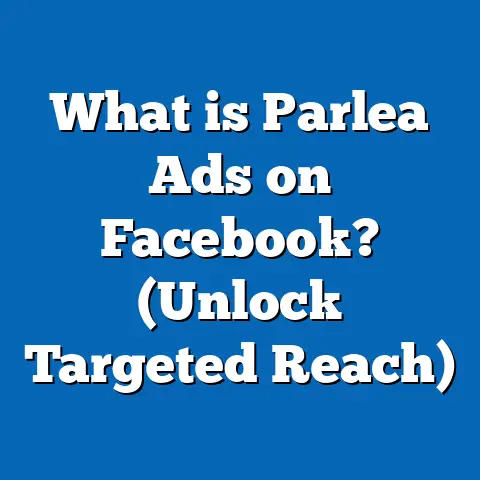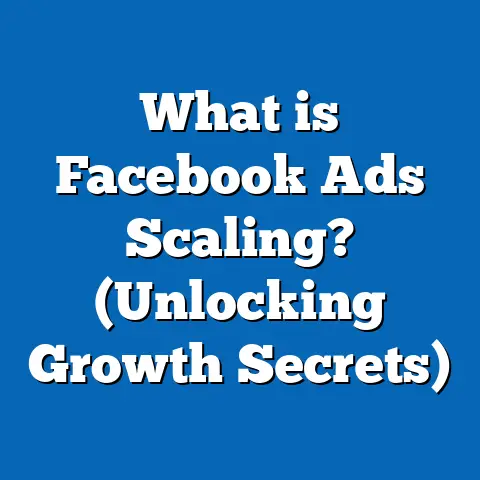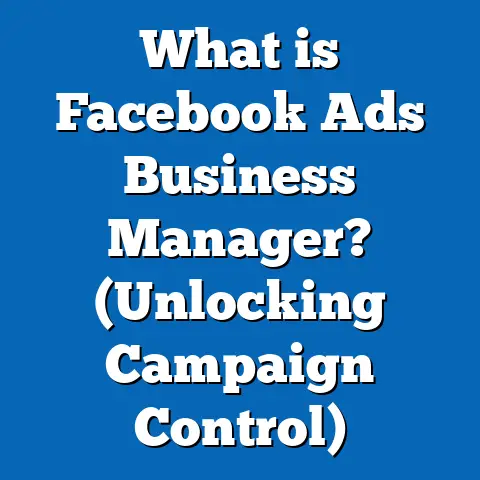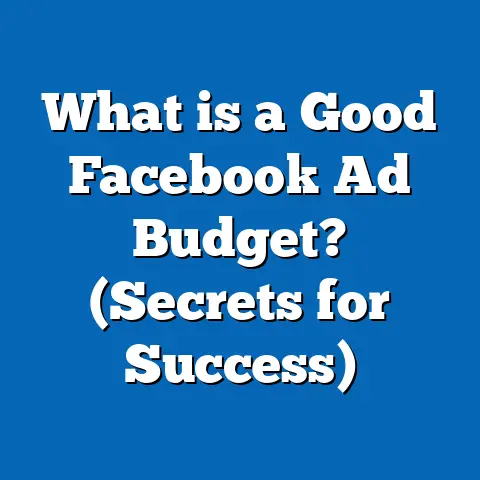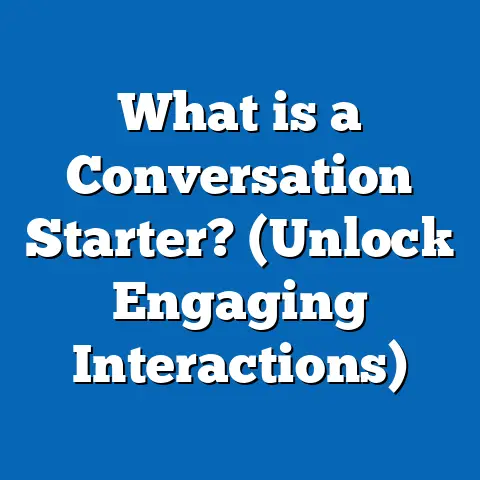What is 4:5 Aspect Ratio for Facebook Ads? (Unlock Engagement)
Introduction: Why Aspect Ratios Matter in Your Daily Digital Life
In today’s fast-paced digital world, your daily lifestyle is deeply intertwined with the content you consume on social media platforms like Facebook. Whether you’re checking updates during your morning coffee, catching up on news during a commute, or unwinding with short videos before bed, the visual presentation of ads and posts influences how you engage and interact. For marketers and business owners, this means crafting content that not only reaches audiences but also grabs attention in an ever-crowded feed.
One of the most overlooked yet essential factors in creating engaging ads is the aspect ratio—the relationship between an image or video’s width and height. Among several aspect ratios commonly used on Facebook, the 4:5 aspect ratio has emerged as a favorite due to its balance between visibility and user experience on mobile devices.
Understanding the 4:5 aspect ratio and how to use it effectively can unlock significantly higher engagement levels, better ad performance, and ultimately improved return on investment (ROI) for your campaigns. This guide walks you through everything you need to know—from what it means technically to how to implement it strategically.
What Is the 4:5 Aspect Ratio?
Defining Aspect Ratio in Simple Terms
Aspect ratio is a fundamental concept in digital media that describes the proportional relationship between an image or video’s width and height. It is written as two numbers separated by a colon—for example, 4:5 means the width is 4 units, and the height is 5 units.
Think of it as a frame shape:
- A square image has an aspect ratio of 1:1 (width equals height).
- A widescreen video might have a 16:9 ratio (much wider than tall).
- The 4:5 ratio is taller than it is wide but less extreme than full portrait (such as 9:16).
Visualizing 4:5
If you imagine your smartphone screen divided into sections, a 4:5 image occupies more vertical space than a square but doesn’t take up the full screen like a story or reel video. This makes it perfect for Facebook’s mobile feed where users scroll vertically.
Why Does This Matter?
The shape and size of your ad’s visual content directly influence how much space it occupies on a screen and how noticeable it is among other content. The more screen real estate an ad takes, especially in a feed environment, the higher the chance of catching attention.
Why the 4:5 Aspect Ratio Is Critical for Facebook Ads
Mobile-First Consumption Explained
Facebook’s user base is overwhelmingly mobile-first. According to Statista (2023), over 98% of Facebook users access the platform via mobile devices. This means designing ads optimized for vertical viewing is no longer optional; it’s a necessity.
On mobile devices:
- Vertical or near-vertical content naturally fits the screen orientation.
- Ads with taller dimensions (like 4:5) take up more vertical space compared to square or landscape formats.
- More vertical space helps ads stand out as users scroll quickly through their feeds.
How Much More Space Does 4:5 Take?
Compared to a square (1:1) ad:
- A 4:5 aspect ratio ad takes approximately 78% more vertical screen space on mobile news feeds.
- This extra space means more room for images or videos to tell a story or showcase products.
Engagement Metrics Backing Up 4:5 Effectiveness
Facebook’s internal data reveals:
- Ads in 4:5 format experience on average a 30% higher click-through rate (CTR) compared to traditional landscape (16:9) ads.
- Video ads using 4:5 see up to 25% longer view times compared to non-vertical formats.
- Cost per click (CPC) decreases by an average of 18%, making this format more cost-efficient.
These statistics highlight how increasing visual prominence directly correlates with better user interaction and campaign performance.
Technical Breakdown: Understanding How 4:5 Works on Facebook
Optimal Dimensions for 4:5 Format
To ensure your ad looks crisp and professional, use these recommended pixel dimensions:
| Media Type | Recommended Size (pixels) | Aspect Ratio |
|---|---|---|
| Images | 1080 x 1350 | 4:5 |
| Videos | 1080 x 1350 | 4:5 |
| Carousel Images | 1080 x 1350 | 4:5 |
File Formats and Compression
Facebook compresses media files upon upload to optimize loading speed and performance. To minimize quality loss:
- Use high-resolution source files.
- Preferred image formats are JPG or PNG.
- For videos, MP4 or MOV files at high bitrate are best.
- Keep video file sizes under 4 GB for smooth uploading.
Safe Zones and Text Limits
Facebook recommends limiting text overlay to no more than 20% of the image area to avoid reduced delivery or reach penalties. Also:
- Keep important elements (logos, faces, text) within the center “safe zone” to prevent cropping on different devices or placements.
- Avoid placing text too close to edges.
Ad Placement Compatibility
The beauty of the 4:5 aspect ratio is its versatility across Facebook’s ecosystem:
- Facebook News Feed — prime placement where most engagement happens.
- Instagram Feed — shares similar specs with Facebook Feed.
- Facebook Stories & Reels — while full vertical (9:16) is preferred here, slight cropping can accommodate 4:5 ads.
- Audience Network — extended reach with similar aspect ratio support.
Data-Backed Insights and Research Findings
Case Study #1: Retail Brand Boosts Engagement by Switching to 4:5 Ads
A mid-sized retail brand specializing in fast fashion implemented a campaign overhaul by switching their Facebook ads from square (1:1) to vertical 4:5 images and videos.
Results over three months:
- Engagement rate rose by 42%.
- Cost per click (CPC) dropped by 18%.
- Purchase conversion rates increased by 15%.
- Return on Ad Spend (ROAS) improved by 20%.
The success was attributed primarily to increased screen presence and better alignment with mobile user behavior.
Case Study #2: Tech Startup Sees Greater Video Completion Rates
A tech startup promoting a new app launched two video ad sets:
- One in traditional 16:9 format.
- One optimized in 4:5 vertical format.
Findings after six weeks:
- Video completion rates were 35% higher for the 4:5 format.
- Engagement (likes/comments/shares) increased by 28%.
- Cost per install (CPI) fell by 22%.
This demonstrated that even dynamic video content benefits greatly from adopting the vertical-friendly aspect ratio.
Comparative Analysis of Aspect Ratios on Facebook Ads
| Aspect Ratio | Average CTR Increase | Average CPC Change | Engagement Rate | Recommended Use Case |
|---|---|---|---|---|
| 1:1 (Square) | Baseline | Baseline | Baseline | Balanced visibility, multi-device |
| 16:9 (Landscape) | -12% | +10% | Lower | Wide shots, product demos |
| 4:5 (Vertical) | +30% | -18% | Highest | Mobile feed ads, storytelling |
The data clearly favors the 4:5 format for maximizing engagement and cost efficiency in mobile feed environments.
Practical Tips for Implementing 4:5 Aspect Ratio Ads
Crafting Visuals That Pop on Mobile Screens
- Center Your Subject: Keep key elements like faces or products centered vertically so they aren’t cropped.
- Use High Contrast: Strong color contrast helps your ad stand out in cluttered feeds.
- Keep Text Minimal: Use concise headlines and calls-to-action that are legible even on small screens.
- Leverage Negative Space: Don’t overcrowd your design; white space improves readability and focus.
Video Best Practices for 4:5 Ads
- Hook Viewers Quickly: Capture attention within the first 3 seconds to reduce scroll past.
- Add Captions: Since many users watch videos muted, captions convey your message without sound.
- Focus on Storytelling: Use vertical framing to create immersive narratives that feel natural on mobile.
- Optimal Length: Keep videos between 15–30 seconds for maximum retention.
- Looping: Short looping videos can increase total watch time.
Tips for Text Optimization
Facebook’s algorithm favors ads with minimal text overlay:
- Use bold fonts sized above 24px for readability.
- Avoid placing text near edges; keep within safe zones.
- Consider using Facebook’s Text Overlay Tool for compliance checks.
Tools & Resources for Creating 4:5 Content
- Facebook Ads Manager: Preview how your ads display across placements and aspect ratios.
- Canva: User-friendly design tool with custom dimension templates.
- Adobe Photoshop/Illustrator: For professional-grade image editing with precise control over dimensions.
- InShot / Adobe Premiere Rush: For editing vertical videos optimized for social media.
How Facebook’s Algorithm Interacts with Aspect Ratios
Facebook’s Goal: Maximize User Engagement
Facebook’s algorithm prioritizes content that keeps users scrolling and interacting longer. Ads that occupy more screen space tend to:
- Get noticed more quickly.
- Encourage longer viewing times.
- Generate increased interactions such as likes, comments, shares, and clicks.
Impact of Video Format on Algorithmic Reach
Videos optimized in vertical or near vertical formats like 4:5 receive:
- Higher relevance scores from Facebook’s ad delivery system.
- Increased likelihood of being shown organically within user feeds.
Videos not optimized for mobile may be penalized with lower reach due to poor user experience.
Cross-Platform Synergies Using 4:5 Aspect Ratio
Instagram & Facebook Integration
Because Instagram feed uses almost identical specs to Facebook’s feed, creating assets in 4:5 aspect ratio allows seamless cross-posting without modification. This saves time and resources while maintaining consistent branding across platforms.
Leveraging Audience Network & Messenger
Ads with vertical-friendly formats like 4:5 also perform well in Facebook’s Audience Network (third-party apps) and Messenger placements where mobile devices dominate user access.
Advanced Strategies for Maximizing 4:5 Impact
Segmenting Audiences by Device Usage
Use Facebook Audience Insights to identify segments heavily using mobile devices. Deliver tailored creatives optimized in 4:5 format to these groups for improved results.
Combining Carousel Ads with Vertical Images
Using multiple images/videos in a carousel format allows storytelling through sequential vertical frames, increasing engagement opportunities.
Interactive Elements & Call-To-Actions
Place CTAs prominently within safe zones ensuring clickable buttons are fully visible on all devices.
Common Challenges When Using the 4:5 Aspect Ratio & Solutions
| Challenge | Description | Solution |
|---|---|---|
| Cropping Across Placements | Some placements crop images differently | Use safe zones; preview placements before launch |
| File Size & Quality Loss | Compression reduces image/video quality | Upload high resolution; avoid heavy filters |
| Text Visibility | Small fonts become unreadable | Use larger fonts; test on different devices |
| Creative Limitations | Limited horizontal space for wide product shots | Use close-ups or multiple images in carousel |
Future Trends in Facebook Ad Formats & Aspect Ratios
Increasing Mobile Video Consumption
Mobile video consumption continues to rise globally. Vertical formats like 4:5 are expected to become standard as platforms optimize for mobile-first experiences.
AI-Powered Dynamic Creative Optimization
Facebook is investing in AI tools that automatically adjust aspect ratios and layouts based on audience preferences—giving marketers opportunities to test and adapt quickly.
Augmented Reality & Immersive Ads Integration
With AR ads growing, vertical-friendly formats will be crucial as these experiences often take place in portrait mode on smartphones.
Summary & Next Steps for Marketers
Key Takeaways
- The 4:5 aspect ratio offers optimal vertical screen space utilization without overwhelming viewers.
- It drives stronger engagement metrics including CTR, watch time, and conversions.
- Proper technical setup ensures high-quality delivery across placements.
- Combining creative design best practices with audience targeting maximizes impact.
Action Plan Checklist
- Review your current ad creatives for aspect ratio optimization.
- Create new designs/videos specifically sized at 1080×1350 pixels.
- Run A/B tests comparing performance against other formats like square or landscape.
- Analyze results focusing on engagement rates, CPC, conversion rates, and ROAS.
- Adjust campaigns based on insights and stay informed about evolving platform updates.
By mastering the use of the 4:5 aspect ratio in your Facebook ads strategy, you align your marketing efforts perfectly with mobile user behavior—boosting visibility, engagement, and profitability in today’s competitive digital marketplace.

